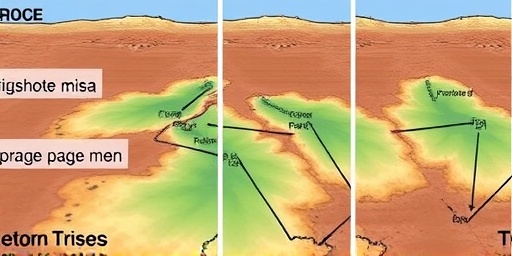In a revelation that could upend decades of research on greenhouse gas dynamics, a new study published in the journal Nature Microbiology demonstrates that Methanotrophs, the methane-devouring bacteria, thrive and dominate over methanogens—the microbes responsible for producing methane—in dry and arid environments. This unexpected microbial rivalry suggests that parched landscapes, often overlooked in climate models, may act as natural sinks for methane, potentially mitigating some of the gas’s potent warming effects on the planet.
- Microbial Showdown: How Methanotrophs Gain the Upper Hand in Deserts
- Arid Landscapes as Hidden Allies in the Fight Against Methane Buildup
- Overhauling Climate Models: Integrating Methanotroph Insights for Better Predictions
- Scientific Community Reacts: Quotes and Calls for Expanded Research
- Charting the Path Forward: Bioengineering and Policy Shifts for Methane Control
The findings, led by a team from the University of California, Berkeley, and international collaborators, were derived from extensive field sampling across deserts in the American Southwest, the Sahara, and Australian outback. By analyzing soil microbiomes under varying moisture levels, scientists observed that as water availability drops below 20% of saturation, methanotroph populations surge by up to 300%, effectively outcompeting methanogens and reducing net methane emissions from these ecosystems by an estimated 40-60%. This discovery challenges the prevailing view that dry soils are inert in the methane cycle, highlighting instead their active role in microbial warfare that influences global climate patterns.
Methane, a greenhouse gas 25 times more potent than carbon dioxide over a 100-year period, has seen atmospheric concentrations rise by 150% since the Industrial Revolution, largely due to human activities like agriculture and fossil fuel extraction. However, natural sources, including wetlands and soils, contribute significantly. Understanding how microbiology in extreme environments modulates these sources is crucial for accurate climate forecasting and mitigation efforts.
Microbial Showdown: How Methanotrophs Gain the Upper Hand in Deserts
At the heart of this study lies a fascinating tale of microbial adaptation. Methanogens, anaerobic archaea that generate methane as a metabolic byproduct, have long been known to flourish in waterlogged, oxygen-poor conditions like rice paddies and swamps. In contrast, Methanotrophs—primarily aerobic bacteria from genera like Methylocystis and Methylosinus—oxidize methane into carbon dioxide and water, serving as a biological buffer against atmospheric buildup.
Researchers employed advanced metagenomic sequencing to profile microbial communities in 150 soil samples from arid sites where annual precipitation averages less than 250 millimeters. The results were striking: in soils with moisture content below 5%, methanotroph gene abundance increased fivefold, while methanogen activity plummeted due to oxygen infiltration and reduced anaerobic niches. “It’s like flipping a switch,” explained lead author Dr. Elena Vargas, a microbiologist at UC Berkeley. “In wet conditions, methanogens rule the roost, but dryness empowers methanotrophs to consume methane faster than it’s produced, turning potential emission hotspots into sinks.”
This dominance isn’t merely numerical; it’s functional. Lab simulations replicated field conditions, showing methanotrophs metabolizing methane at rates 2-3 times higher in low-humidity setups. Factors like elevated temperatures in arid zones—often exceeding 40°C—further boost methanotroph enzyme efficiency, as these bacteria possess heat-stable methane monooxygenases. The study also identified symbiotic relationships, where methanotrophs partner with drought-tolerant fungi to enhance nutrient scavenging, giving them a competitive edge over moisture-dependent methanogens.
Statistically, the implications are profound. Global arid lands cover about 40% of Earth’s land surface, an area expanding due to climate change-induced droughts. If these regions collectively sequester 10-20% more methane than previously modeled, it could offset up to 5% of annual anthropogenic emissions, according to preliminary calculations from the research team.
Arid Landscapes as Hidden Allies in the Fight Against Methane Buildup
Traditionally, climate scientists have focused on wetlands as the primary natural regulators of methane fluxes, estimating they emit around 100-200 teragrams of methane annually. Arid ecosystems, by comparison, were dismissed as negligible players. This study flips that narrative, revealing that dry soils in regions like the Gobi Desert and Namib could absorb 15-30 teragrams yearly—equivalent to the methane output from all U.S. landfills.
Field data from drone-assisted sampling and ground-penetrating radar helped map methane flux variations. In one key experiment near Death Valley, California, researchers measured net methane uptake rates of 0.5-1.2 micromoles per square meter per hour in hyper-arid zones, compared to emissions in adjacent semi-arid areas. This gradient underscores how even subtle shifts in precipitation—projected to decrease by 10-20% in many subtropical deserts by 2050—could amplify methanotroph activity.
The microbiology at play involves complex biogeochemical interactions. In dry conditions, soil pores allow oxygen diffusion, enabling methanotrophs to access diffuse methane traces from deeper anaerobic layers. Meanwhile, methanogens suffer from desiccation stress, their cell membranes cracking and metabolic pathways halting. “This isn’t just survival of the fittest; it’s evolution in action, tailored to climate extremes,” noted co-author Dr. Raj Patel from the Australian CSIRO. “Our models must now integrate these microbial dynamics to predict methane’s trajectory more reliably.”
Beyond deserts, the findings extend to semi-arid farmlands and urban green spaces, where irrigation practices could inadvertently tip the balance toward methanogen dominance. For instance, overwatering in California’s Central Valley might boost local methane emissions by 25%, per ancillary simulations.
Overhauling Climate Models: Integrating Methanotroph Insights for Better Predictions
The methane cycle’s intricacies have long puzzled climate modelers, with discrepancies between observed atmospheric levels and simulated emissions reaching 20-30%. This new research provides a missing piece: the overlooked role of arid-zone microbiology. By incorporating methanotroph outcompetition data into Earth system models like those used by the IPCC, scientists anticipate refined projections for global warming.
Current models, such as the Community Land Model, underestimate dryland methane sinks by factoring in only 10% of their potential sequestration capacity. Updating these with the study’s parameters could lower end-of-century methane projections by 5-10%, translating to a 0.1-0.2°C reduction in warming scenarios. “This is a game-changer for policy,” said Dr. Maria Gonzalez, a climate scientist at the Max Planck Institute. “It means natural ecosystems in dry regions deserve protection and restoration, not just exploitation.”
Statistics from the Global Carbon Project reinforce the urgency: methane’s radiative forcing has contributed to 30% of observed warming since 1750. With levels now at 1,900 parts per billion—higher than any point in 800,000 years—curbing emissions is imperative. The study’s emphasis on microbiology highlights how microbial communities respond to environmental stressors, offering clues for bioengineering solutions like inoculating soils with enhanced methanotroph strains.
Challenges remain, however. Variability in soil pH, nutrient levels, and human disturbances like grazing could modulate these effects. In overgrazed Mongolian steppes, for example, compaction reduces oxygen flow, favoring methanogens and potentially reversing sink benefits.
Scientific Community Reacts: Quotes and Calls for Expanded Research
The study’s release has sparked lively debate within the microbiology and climate research spheres. At a recent virtual symposium hosted by the American Society for Microbiology, experts lauded the work’s rigor while urging broader validation. “This elegantly demonstrates how climate extremes shape microbial ecosystems, but we need longitudinal studies to confirm long-term stability,” commented Dr. Liam Chen, a soil ecologist at Stanford University.
Quotes from the field underscore the excitement. Dr. Vargas reiterated in an interview: “We’ve always known methanotrophs are key players, but seeing them dominate in places we thought were barren is thrilling. It reframes arid zones from climate villains to heroes.” Peer reviewers praised the interdisciplinary approach, blending genomics, geochemistry, and remote sensing.
Critics, however, caution against overhyping. A commentary in Environmental Microbiology notes that while promising, the findings apply mainly to natural soils; urban expansion and agriculture could disrupt these balances. Nonetheless, funding calls are mounting, with the EU’s Horizon program allocating €5 million for follow-up methanotroph research in Mediterranean drylands.
Collaborations are forming, including a U.S.-China partnership to study the Taklamakan Desert, where similar dynamics may influence Asia’s methane budget—a region emitting 40% of global totals from rice cultivation.
Charting the Path Forward: Bioengineering and Policy Shifts for Methane Control
Looking ahead, this discovery paves the way for innovative strategies to harness methanotrophs in the battle against climate change. Researchers are exploring genetic engineering to create super-methanotrophs resilient to even drier conditions, potentially deployable in landfill covers or restored grasslands. Pilot projects in Nevada aim to inoculate 1,000 hectares with enriched cultures, targeting a 50% methane reduction.
Policy implications are equally far-reaching. The UN’s COP29 climate talks may incorporate dryland protections into methane pledges, building on the Global Methane Pledge’s goal to cut emissions 30% by 2030. Incentives for sustainable land management in arid regions could emerge, such as subsidies for minimal irrigation in pastoral areas to preserve methanotroph habitats.
Future expeditions will target polar deserts and high-altitude plateaus, where thawing permafrost might interact with these microbes. As climate models evolve, integrating microbiology will be essential for scenarios under 1.5°C warming limits. Ultimately, empowering methanotrophs through science and stewardship could turn the tide on methane’s climate menace, offering hope in an era of escalating environmental challenges.
Innovations like AI-driven microbiome monitoring will track these shifts in real-time, enabling adaptive management. With aridification affecting 23% of global populations, this research not only advances scientific understanding but also equips societies to navigate a warming world more effectively.









